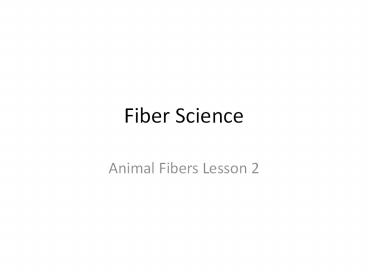Fiber Science PowerPoint PPT Presentation
Title: Fiber Science
1
Fiber Science
- Animal Fibers Lesson 2
2
I. Wool production
- A. Wool has likely been used longer than any
other fiber by humans to make clothing - B. Early humans may have started using sheep
skins for clothing - 1. Soon discovered that the wool fibers could
be twisted into thread - 2. Realized animals did not have to be killed
to harvest fibers and the animal continued to
grow wool fiber - 3. May even have started a selective breeding
program to develop sheep with finer wool
3
C. Wool is highly desired for fabric 1. Durable
2. Warm in the winter 3. Can be worn in the
summer because it absorbs moisture 4. Lends
itself to a variety of uses a. Fine
garments b. Durable garments c. Tapestriesd.
d. Blankets e. Rugs
4
D. Wool animals 1. Sheep 2. Angora
goats 3. Alpacas 4. LLamas E. Wool
characteristics 1. Wool is made of type of
protein called keratin (also found in horns,
hooves, fingernails, and skins) 2. On animals,
wool has both primary follicles that produce
coarser, outer hair (designed to keep water away
from body) and finer, inner hairs that provide
insulation
5
- 3. Wool grows by adding cells to the hair
structure - a. Cells overlap and resemble scales
- b. Scales help fibers mat and hold together
(i.e. felt, yarn) - 4. Wool has a wavy appearance crimp the more
crimp, the more desirable the wool
6
- 5. The skin secretes a grease-like substance from
the skin that helps keep the wool soft, pliant,
and able to shed water (live animal substance
yolk processed substance lanolin)
7
F. Wool processing
- 1. Wool is shorn from the sheep
- 2. Shorn wool is bundled together not cleaned
and called grease wool - 3. Process of cleaning (removing the yolk/foreign
material) is called scouring
8
- 4. Wool is graded (assigned a quality rating)
- 5. Wool is blended with other wool fibers to
create a particular type of wool fabric - 6. After blending, the fibers are untangled
(called carding) - 7. Carded fibers are spun and twisted together to
form thread/yarn to be woven into cloth
9
II. Silk production
- A. Silk probably originated in Ancient China
around 2600 BC - B. Hundreds of years later, silk was produced and
marketed in many parts of Asia
10
- C. Characteristics of silk
- 1. Silk is the strongest of all natural fibers
and tends to hold its shape well - 2. Silk fibers are very fine (.00059 to .00118
inch in diameter), and very long - (Length of fiber contributes to its strength)
- 3. Silk is very receptive to dyeing and shows
colors well - 4. Silk cloth is comfortable and absorbs
moisture better than any of the other natural
fibers
11
D. Sericulture
- 1. Sericulture culture of the silk worm
- 2. Out of over 30,000 species of spiders and
113,000 species of insects that make silk
(insect order Lepidoptera) most silk is
produced by the moth Bombyx mori. - 3. Thailand, China, and Japan are leading
countries in sericulture
12
4. Silk-making process
- a. An adult female moth lays around 700 eggs
(no larger than a pinhead) on specially prepared
paper - b. When the eggs begin to hatch, they are laid
on bamboo frames covered with mulberry
leaves - c. Tiny larva hatch and feed on the leaves
- i. May devour 30,000 times their weight at
hatching - ii. May increase their hatch weight up to
10,000 times
13
- d. The larva grow for a period of about 35 days
- i. Larva shed their skins four times
- ii. Larva grow to a length of about 3 inches and
½ inch diameter
14
- e. After the growth period, the larva attaches
itself to a straw structure placed on the pad,
and begins to spin a cocoon - i. Silk material for the cocoon is secreted
from two glands inside the larvas mouth - ii. Silk is forced out of the mouth through two
openings called spinnerets - iii. The cocoon is completed in 2-3 days and
may contain as much as a mile of silk filament
15
- f. As the larva begins to go through
metamorphosis, it is killed with heat and the
silk collected some larva are allowed to
continue living, grow into adults and are used
for breeding/laying eggs - g. Collection of silk filaments
- i. Each cocoon usually produces about 100 yards
of combined filaments - ii. Silk taken from the cocoon is called raw
silk

